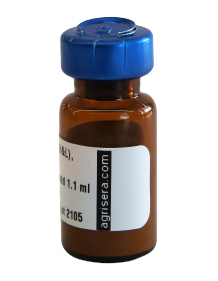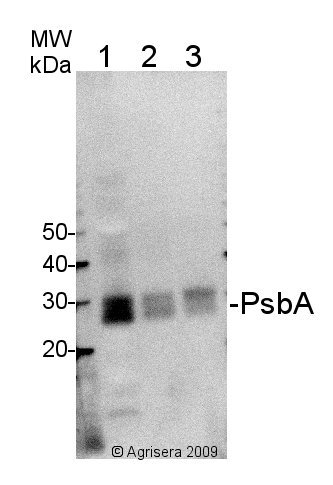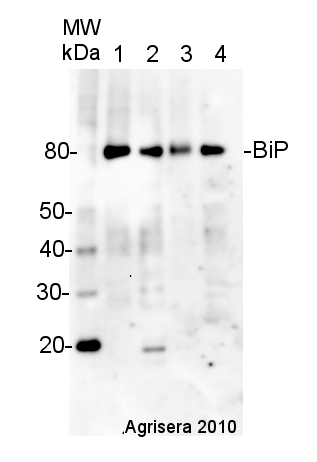1

Goat anti-Chicken IgY (H&L), HRP conjugated
AS09 603 | Clonality: Polyclonal | Host: Goat | Reactivity: Hen IgY (H&L)
- Product Info
-
Immunogen: Purified chicken IgY, whole molecule Host: Goat Clonality: Polyclonal Purity: Immunogen affinity purified goat IgG. Format: Lyophilized Quantity: 1 mg Reconstitution: For reconstitution add 1.1 ml of sterile water. Let it stand 30 minutes at room temperature to dissolve. Prepare fresh working dilutions daily Storage: Store lyophilized material at 2-8°C. For long time storage after reconstitution, dilute the antibody solution with glycerol to a final concentration of 50% glycerol and store as liquid at -20°C, to prevent loss of enzymatic activity. For example, if you have reconstituted 1 mg of antibody in 1.1 ml of sterile water add 1.1 ml of glycerol. Such solution will not freeze in -20°C. If you are using a 1:5000 dilution prior to diluting with glycerol, then you would need to use a 1:2500 dilution after adding glycerol. Prepare working dilution prior to use and then discard, Be sure to mix well but without foaming. Tested applications: ELISA (ELISA), Immunohistochemistry (IHC), Western blot (WB) Recommended dilution: 1 : 10 000 -1 : 150 000 (ELISA), 1 : 500 -1 : 5000 (IHC), 1 : 20 000 and 1 : 10 000 (WB) - Reactivity
-
Confirmed reactivity: Chicken IgY heavy and light chains (H&L). Not reactive in: No confirmed exceptions from predicted reactivity are currently known - Application Examples
-
Application example

5 µg of total extract from (1) Hordeum vulgare total leaf, (2) Zea mays (3) Spinacia oleracea extracted with PEB (AS08 300) were separated on 4-12% NuPage (Invitrogen) LDS-PAGE and blotted 1h to PVDF. Blots were blocked immediately following transfer in 2% ECL Advance blocking reagent (GE Healthcare) in 20 mM Tris, 137 mM sodium chloride pH 7.6 with 0.1% (v/v) Tween-20 (TBS-T) for 1h at room temperature with agitation. Blots were incubated in the primary anti-PsbA antibody (AS01 016) at a dilution of 1: 10 000 for 1h at room temperature with agitation. The antibody solution was decanted and the blot was rinsed briefly twice, then washed once for 15 min and 3 times for 5 min in TBS-T at room temperature with agitation. Blots were incubated in secondary antibody (anti-hen IgG horse radish peroxidase conjugated, AGRISERA) diluted to 1:50 000 in 2% ECL Advance blocking solution for 1h at room temperature with agitation. The blots were washed as above and developed for 5 min with chemiluminescen detection reagent according to the manufacturers instructions. Images of the blots were obtained using a CCD imager (FluorSMax, Bio-Rad) and Quantity One software (Bio-Rad). Exposure time was 30 seconds.

5 µg of total protein from A.thaliana (1), H. vulgare (2), Z.mays (3), S. oleracea (4), extracted with Agrisera PEB extraction buffer (AS08 300) were separated on 4-12% SDS-PAGE and blotted 1h to PVDF. Blots were blocked immediately following transfer in for 1h at room temperature with agitation. Blots were incubated in the primary antibody at a dilution of 1: 10 000 for 1h at room temperature with agitation. The antibody solution was decanted and the blot was rinsed briefly twice, then washed once for 15 min and 3 times for 5 min in TBS-T at room temperature with agitation. Blots were incubated in secondary antibody (anti-hen IgY horse radish peroxidase conjugated, from Agrisera AS09 603) diluted to 1:50 000 for 1h at room temperature with agitation. The blots were washed as above and developed for 5 min with ECL detection reagent according to the manufacturers instructions. Exposure time was 5 seconds.
- Additional Information
-
Additional information: Concentration: 1.0 mg/ml
This HRP-conjugate is supplied in 10 mM Sodium Phosphate, 0.15 M Sodium Chloride, pH 7.2, 1 % (w/v) BSA, Protease/IgG free 0.1 % (v/v) of Kathon CG is used as preservative.Additional information (application): Antibody binds to:
heavy chains on chicken IgY
light chains on all chicken immunoglobulins
No reactivity is observed to non-immunoglobulin chicken serum proteins based in immunoelectrophoresis.Chicken immunoglobulin is often called hen or chicken IgG, however it is derived from egg yolk, therefore IgY.
- Background
-
Background: Goat anti-chicken IgY (H&L) is a secondary antibody conjugated to HRP (horse radish peroxidase) which binds to chicken IgY in immunological assays.
- Product Citations
-
Selected references: Bindari et al. (2020). Methods to prevent PCR amplification of DNA from non-viable virus were not successful for infectious laryngotracheitis virus. PLoS One. 2020 May 22;15(5):e0232571. doi: 10.1371/journal.pone.0232571. PMID: 32442180; PMCID: PMC7244108.
Levitan et al. (2019). Structural and functional analyses of photosystem II in the marine diatom Phaeodactylum tricornutum. Proc Natl Acad Sci U S A. 2019 Aug 27;116(35):17316-17322. doi: 10.1073/pnas.1906726116.
Heard et al. (2015). Identification of Regulatory and Cargo Proteins of Endosomal and Secretory Pathways in Arabidopsis thaliana by Proteomic Dissection. Mol Cell Proteomics. 2015 Jul;14(7):1796-813. doi: 10.1074/mcp.M115.050286. Epub 2015 Apr 21.
Huang et al. (2015). Effects of exogenous salicylic acid on the physiological characteristics of Dendrobium officinale under chilling stress. Plant Growth Regulation pp 1-10. - Protocols
- Agrisera Western Blot protocol and video tutorials
- Reviews:
-
Carole Dabney-Smith | 2020-12-04Excellent HRP-conjugated secondary antibody to detect report on our chicken-derived primary antibodies. We use it for western blot detection at 1:25,000.

